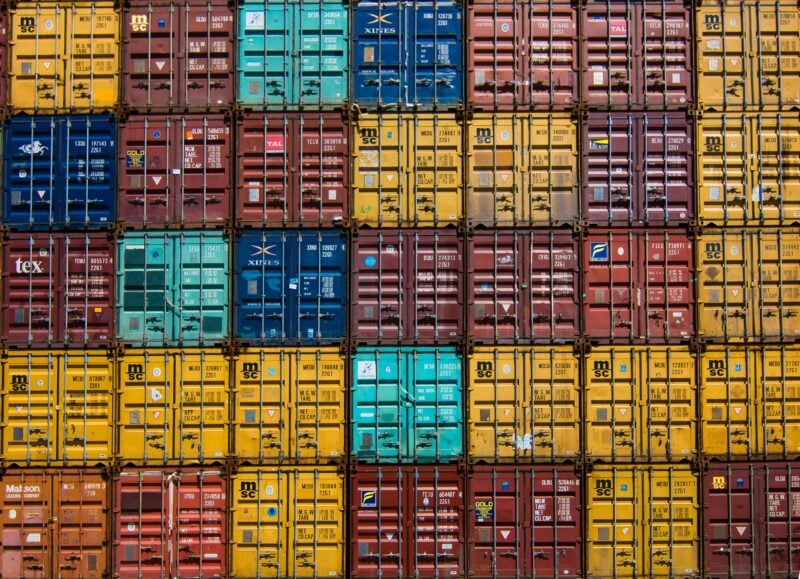Navigating worldwide shipping can feel overwhelming. With over 195 countries in the world, each with its own customs regulations and shipping procedures, it’s easy to get lost.
This comprehensive guide will demystify global delivery by highlighting different services available, explaining how to prepare your packages for transport and offering tips on minimizing costs.
Ready? Let’s set sail into the ultimate guide to worldwide shipping!
Understanding Worldwide Shipping
Worldwide shipping refers to the transportation of goods and products across international borders, with various factors to consider such as customs regulations, packaging requirements, and potential challenges that may arise during the process.
The difference between domestic and international shipping
Domestic shipping sends goods within the same country. You can send a package from one town to another or across states. It’s usually cheaper and faster than international shipping.
On the other hand, international shipping is when you send goods to a different country. The price is often higher because it takes more work and time. This type of shipping has rules that differ for each country too.
Both types aim to get items from one place to another, but they do have key differences worth noting.
Factors to consider when shipping globally
When shipping globally, there are several important factors to consider. First, you need to be aware of customs regulations and compliance requirements for the countries you’ll be shipping to.
This includes understanding any restrictions on certain goods, as well as any necessary import or export licenses. Second, it’s crucial to choose a reliable and experienced shipping provider that has expertise in international logistics and transportation services.
Look for a company that offers tracking capabilities and has a strong network of carriers worldwide. Finally, don’t forget about packaging and labeling guidelines. It’s essential to properly pack your items to ensure they withstand the journey and arrive at their destination in good condition.
Common challenges with international shipping
International shipping can come with its fair share of challenges. One common challenge is navigating through customs regulations and compliance requirements. When shipping internationally, you need to ensure that all necessary documentation is prepared correctly and accurately.
Another challenge is the potential for delays caused by weather conditions or unexpected events. It’s important to plan ahead and work with reputable shipping companies that have experience in handling international shipments.
Lastly, calculating and minimizing shipping costs can be a challenge as well. Factors like distance, weight, and destination will impact the overall cost of shipping internationally.
Types of Shipping Services Available
There are several types of shipping services available for worldwide shipping, including parcel shipping, freight shipping, cargo shipping, enterprise logistics services, DHL eCommerce, and DHL Express.
Parcel shipping
Parcel shipping is one of the types of shipping services available for worldwide delivery. It is a convenient option for individuals and businesses who need to send smaller packages or parcels internationally.
When choosing a shipping provider for your parcel, it’s essential to consider factors such as reliability, speed, and cost-effectiveness. You will also need to follow packaging and labeling guidelines to ensure that your package is properly secured during transit.
Additionally, you must be aware of customs and documentation requirements specific to the country you are sending your parcel to. By understanding these considerations and working with a reputable shipping company like DHL Express or DHL eCommerce, you can easily ship your parcels globally with confidence.
Freight shipping
Freight shipping is a type of shipping service that is used to transport large or heavy items internationally. It is often used by businesses and manufacturers who need to ship goods in bulk.
With freight shipping, your items are placed on pallets or in containers and loaded onto ships or planes for transportation. This method allows for efficient and cost-effective transportation of goods across long distances.
Freight shipping services can be provided by logistics companies or freight forwarders, who handle the entire process from pick-up to delivery. When using freight shipping, it’s important to consider factors like packaging and labeling requirements, customs documentation, and the overall cost of shipping your goods.
Cargo shipping
Cargo shipping is an important aspect of worldwide shipping. It involves transporting large quantities of goods and products by sea or air. Cargo ships are specifically designed to carry heavy loads and can transport goods over long distances.
This type of shipping is often used for businesses that need to transport bulk items such as raw materials, machinery, or wholesale products. Cargo shipping services offer different options based on the size and weight of the cargo, including full container loads (FCL) or less-than-container loads (LCL).
It’s essential to choose a reputable cargo shipping company that provides reliable transportation services and handles customs regulations efficiently to ensure smooth delivery of your goods.
Enterprise logistics services
Enterprise logistics services are comprehensive solutions that cater to the unique shipping needs of businesses operating globally. These services offer end-to-end support for managing complex supply chains, ensuring efficient transportation, and optimizing customs compliance.
With enterprise logistics services, companies can access a wide range of shipping options, including freight shipping and cargo shipping. They also benefit from expert guidance on packaging and labeling guidelines, customs documentation requirements, and minimizing shipping costs.
By partnering with reputable providers like DHL Express or DHL eCommerce, businesses can streamline their international shipping processes and focus on growing their operations worldwide.
DHL eCommerce
DHL eCommerce is a shipping service that specializes in international deliveries. They offer reliable and cost-effective solutions for e-commerce retailers who need to ship their products worldwide.
With DHL eCommerce, you can choose from a range of shipping options, including parcel shipping, freight shipping, and cargo shipping. They also provide enterprise logistics services to streamline your supply chain and ensure smooth operations.
DHL eCommerce takes care of all the necessary customs compliance and documentation requirements, making it easier for you to ship internationally. Plus, they have competitive rates and innovative solutions to help calculate and minimize your shipping costs.
DHL Express
DHL Express is a global shipping service that provides fast and reliable delivery worldwide. Whether you need to send a small package or a large shipment, DHL Express offers a range of shipping options to meet your needs.
They have extensive experience in international shipping and can help you navigate customs regulations, documentation requirements, and any other challenges that may arise. With DHL Express, you can track your shipment every step of the way using their advanced tracking technology.
They are committed to providing excellent customer service and ensuring your shipment arrives on time and in good condition.
How to Ship Internationally
Choose a shipping provider, follow packaging guidelines, meet customs requirements, and calculate shipping costs to ensure successful international shipments. Discover more essential tips in our comprehensive guide to worldwide shipping!
Choosing a shipping provider
When it comes to choosing a shipping provider for your international shipments, there are a few factors you should consider. First, think about the reputation and experience of the company.
Look for providers that have a proven track record in handling global shipments efficiently and reliably. Second, consider the range of services they offer. Make sure they can meet your specific needs, whether it’s parcel shipping or freight shipping.
Third, pay attention to their customer service. You want a provider that is responsive and helpful when it comes to any concerns or issues with your shipments. And finally, don’t forget to compare prices and fees among different providers to ensure you’re getting the best value for your money.
Packaging and labeling guidelines
When shipping internationally, it is important to follow packaging and labeling guidelines. Proper packaging helps ensure that your items arrive safely at their destination. Use sturdy boxes or containers and secure the contents with appropriate padding or cushioning materials.
Additionally, make sure to seal the package securely using strong tape. Labeling guidelines include clearly indicating the sender and recipient’s full names, addresses, and contact information on the package.
It is also important to include any required customs forms or documentation for smooth clearance through customs. By following these packaging and labeling guidelines, you can help minimize any potential issues during international shipping.
Customs and documentation requirements
When shipping internationally, it’s important to understand the customs and documentation requirements. This involves completing necessary paperwork and providing information about the contents of your shipment.
Customs regulations vary by country, so it’s crucial to research and comply with the specific rules of the destination country. Important documents may include commercial invoices, packing lists, and certificates of origin.
Additionally, you may need to provide details such as item descriptions, quantities, values, and harmonized system codes for each product being shipped. It’s essential to accurately complete these documents to avoid any delays or issues with customs clearance.
Calculating and minimizing shipping costs
Shipping costs can greatly impact your bottom line, so it’s important to calculate and minimize them. To determine shipping costs, consider factors such as the weight and dimensions of your package, the destination country, and the shipping service you choose.
Many shipping providers offer online calculators that can help you estimate costs based on these factors. To minimize shipping costs, consider bundling multiple items into one shipment whenever possible to take advantage of volume discounts.
Additionally, research different shipping providers to compare rates and services offered. Negotiating contracts or using a fulfillment partner may also help reduce costs. By being strategic about calculating and minimizing shipping costs, you can save money while still providing reliable worldwide delivery for your customers.
Keeping Up with the Latest Trends and Innovations in Worldwide Shipping
The blog will explore the latest trends and innovations in worldwide shipping, including green logistics, technology advancements in tracking and managing shipments, the DHL Global Connectedness Index, and industry-specific shipping solutions.
Green logistics
Green logistics is an important trend in the worldwide shipping industry. It focuses on reducing the environmental impact of transportation and delivery services. Companies are adopting sustainable practices like using electric vehicles, optimizing routes to minimize fuel consumption, and implementing recycling programs.
By embracing green logistics, businesses can not only reduce their carbon footprint but also gain a competitive edge by appealing to environmentally conscious consumers. As a consumer, you can support green logistics by choosing shipping providers that prioritize sustainability and making eco-friendly choices when packaging your items for shipment.
Technology advancements in tracking and managing shipments
Technology advancements have greatly improved the way shipments are tracked and managed worldwide. With the help of innovative technologies, companies can now easily monitor the location and status of their shipments in real-time.
This allows for better transparency and visibility throughout the entire shipping process. Advanced tracking systems use GPS, RFID, and barcode scanning to provide accurate updates on the whereabouts of packages or cargoes.
This not only ensures that shipments reach their destinations on time but also helps in identifying any potential issues or delays along the way. Additionally, technology has made it easier to manage logistics operations efficiently by automating processes such as inventory management and supply chain optimization.
DHL Global Connectedness Index
The DHL Global Connectedness Index measures how connected countries are to the rest of the world. It looks at factors like trade, information flow, and capital flow. The index helps businesses understand global markets and make informed decisions when shipping internationally.
By analyzing data from over 200 countries, the index provides valuable insights into global trade patterns and trends. This information can be useful for ecommerce retailers looking to expand their market reach or companies planning international shipments.
Keeping up with the DHL Global Connectedness Index can help businesses stay competitive in the global marketplace.
Industry-specific shipping solutions
For businesses in specific industries, there are shipping solutions that cater to their unique needs. These industry-specific shipping solutions can include specialized packaging and handling for delicate goods, temperature-controlled transportation for perishable items like food and pharmaceuticals, as well as secure transport for high-value products such as jewelry or electronics.
By utilizing these tailored services, businesses can ensure that their shipments arrive safely and securely, meeting the specific requirements of their industry. Whether you’re in the healthcare sector, fashion industry, or any other field, it’s important to explore the industry-specific shipping solutions available to you to streamline your logistics operations.



























































































